 AA Pilot Skills Test: All You Need to Know to Ace the American Airlines Pilot Assessment Test [2025]
AA Pilot Skills Test: All You Need to Know to Ace the American Airlines Pilot Assessment Test [2025]
Known for its rigorous pilot recruitment process, American Airlines utilizes computerized aptitude testing to assess the skills, cognitive abilities, and competencies required of pilots.
Our test preparation resources are designed to excel in American Airlines' assessment test. With the AA Pilot Skills Test preparation pack, you will get comprehensive study materials to help you navigate this challenging test, including full test simulations, answering strategies, and detailed scoring reports. It is designed to sharpen all the needed skills, from numerical and logical reasoning to spatial memory, sense of direction, and reaction speed, ensuring you are well-prepared to excel and secure a pilot position at American Airlines.
Applying for another American Airline position? Check out our American Airlines Flight Attendants and Cabin Crew preparation pack or learn more about the American Airlines Hiring Process
Exciting update! Our PrepPack now includes three new versions of the Multitasking Game.
- New! 3 Multitasking Game Versions
- Full Applied Numeracy (scales tmt) Simulation & 8 Extra Practices
- 3 Deductive-Logical Thinking (GapChallenge) Simulations
- 4 Inductive Reasoning (scales clx) Simulations
- 2 Monitoring Ability (scales cmo) Simulations
- Full Reaction Speed (scales rt) Simulation
- 4 Sense of Direction (scales nav) Simulations
- 3 Spatial Memory Simulations
What Is the AA Pilot Skills Test?
American Airlines incorporates Aon's (cut-e) cognitive ability assessments into its extensive pilot screening process. The AA pilot skills test consists of 9 mini-tests, each focusing on assessing specific skills essential for the role of an American Airlines pilot.
Let’s go over them!
AA Pilot Skills Test Questions
Applied Numeracy Test (scales tmt)
This test assesses your numerical reasoning and calculation abilities across four areas: unit conversion, percentage calculation, rule of three, and areas and spaces.
You will receive a passage with information and a multiple-choice question. Your task is to perform the necessary calculations to determine the correct answer.
You will have 16 minutes to answer 20 questions.
The total cost of an electric bill is $318.00. If 6% tax, which is added to the cost of the electricity, is included in the $318.00, how much did the electricity cost before tax?
A. $337.08 B. 19.08$ C. $300 D. $298.92
The bill was for $318, including a 6% tax. Notice that 6% is added to the net cost - that is, the tax is not 6% of 318, but 318 is 106% of the electricity cost. This means 318 is (106/100) = 1.06 times the net electricity cost.
In order to isolate electricity, we will divide each side by 1.06.
That means that:
Electricity × 1.06 = 318
318 ÷ 1.06 =
(318 ÷ 106) × 100 =
3 × 100 =
300
💡 Solving tip
Before trying to solve the question, it may be helpful to first look at the answer choices. Notice that according to answer A the price without tax ($337.08) is higher than the price with tax ($318). Since this cannot be, answer A can be eliminated.
According to answer B, the price without tax ($19.02) is almost $300 less than the price with tax ($318). We know that 6% of 19.02 cannot be anywhere near 298.92 and we can therefore eliminate answer B.
The two remaining answer choices are very close together, $298.92 and $300. Instead of dividing 318/1.06, we can multiply one of these two answer choices by 1.06 and see if we get 318.
We will check 300, as it is a much more comfortable number to work with.
300 × 1.06
= (3 × 100) × (106 ÷ 100)
=3 × 106
=3 × 100 + 3 × 6
= 300 + 18 =
318
300 is therefore the correct answer. Notice that if we would have first multiplied 298.92×1.06 we would have gotten 316.8552. We could have then eliminated answer D and concluded answer C was the correct answer without checking it.
Tip: Not all the information in the passage is relevant to the question. Thus, you need to identify the necessary data to solve the problem.
Deductive-Logical Thinking (Scales lst – GapChallenge)
This test assesses your deductive reasoning and ability to draw conclusions and inferences.
You will be presented with a 4*4 or 5*5 grid with different shapes. One cell in the grid contains a question mark. Each symbol can appear only once in each row and column.
Your task is to determine what shape should be used instead of the question mark.
You will have 6 minutes to answer 15 questions.
What symbol should appear in place of the question mark?



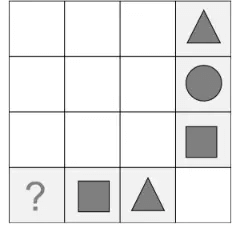
The shape missing from the fourth column is the X.
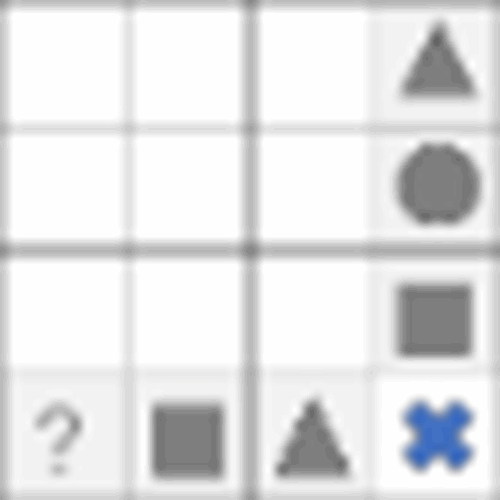
Having added the X to the bottom row, the shape missing from the bottom row is a circle.

Therefore, the correct answer is :

Tip: Since a symbol can appear only once in each row and column, you need to ensure that the symbol you choose as missing does not violate this rule and is not repeated.
Inductive Reasoning (scales clx)
This test assesses your inductive reasoning and the ability to analyze information and recognize rules.
You will be presented with two 3×3 grids with different shapes. Both grids follow a specific rule.
Your task is to identify the rule and choose two additional grids that follow it.
The questions become harder as the test goes on.
You will have 6 minutes to answer as many questions as you can.
Choose the two grids that follow the rule.
A. 1,3 B. 2,3 C. 2,4 D. 3, 4
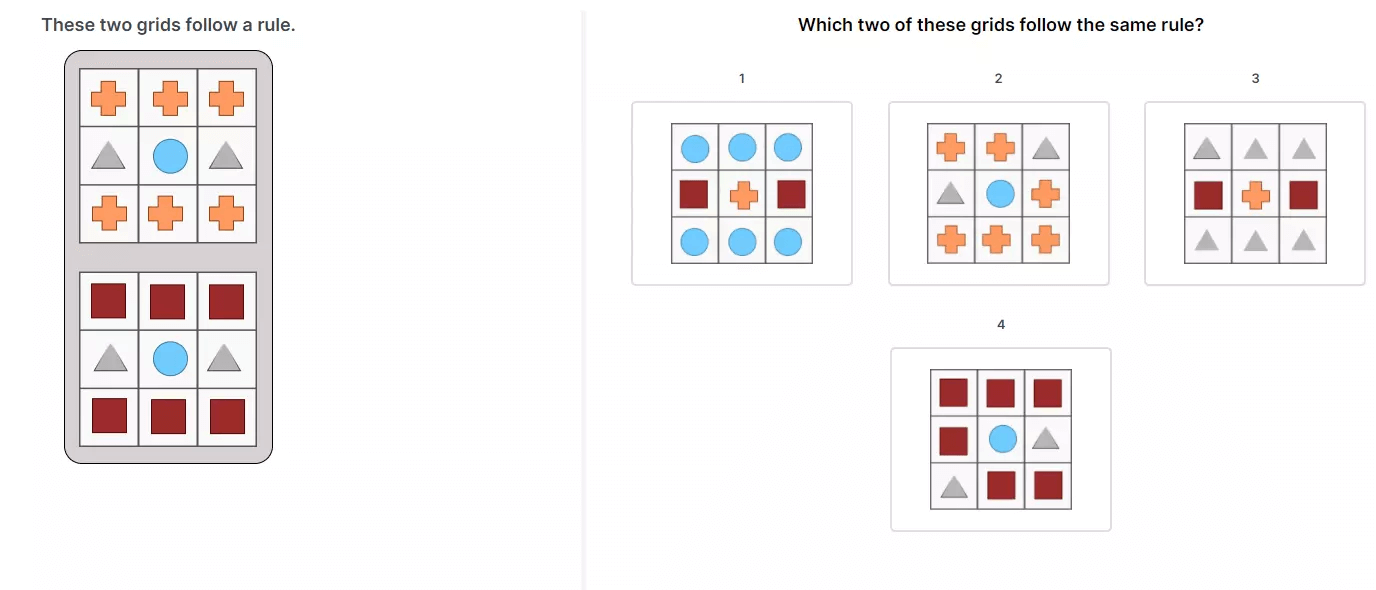
The rule is that each individual grid contains the same shape in the upper row as in the lower row (The upper grids have plus shapes, while the lower grids contain squares). In addition, the middle row is identical for both grids.
Grids 1 and 3 are the only grids that follow this rule. Therefore, The correct answer is 1,3.
Tip: Start by identifying basic patterns, such as the number and type of shapes. Once you've ruled out some options, look at more detailed aspects like their positions.
Monitoring Ability (scales cmo)
This test assesses your perception speed.
You will be presented with a screen displaying moving balls.
Your task is to quickly count the number of moving balls.
The difficulty level rises with each correct response.
You will have 2 minutes to complete as many tasks as you can.

Tip: Group the balls into sets of four, then count the number of sets and multiply that number by four.
Reaction Speed (scales rt)
This test assesses how quickly you respond to a stimulus.
You will be presented with sets of geometric shapes.
Your task is to quickly decide if the shapes are the same.
You have 3 minutes to finish the task.

Tip: Pressing the key when the shapes are different will count as a mistake and lower your score.
Sense of Direction (scales nav)
This test assesses your spatial orientation skills.
You will be presented with an arrow showing the direction the car is driving.
Your task is to choose the accurate maneuver to perform from the driver’s point of view.
You will have 1 minute to complete as many tasks as you can.
Choose the movement direction according to the previous movement and the current arrow. Note that the movement is to the right, left, up, or down, while the maneuver is from the driver’s perspective.
Initial movement:

Select the correct driving maneuver, according to:

Answer Options:
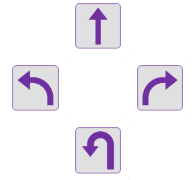
The correct answer is:
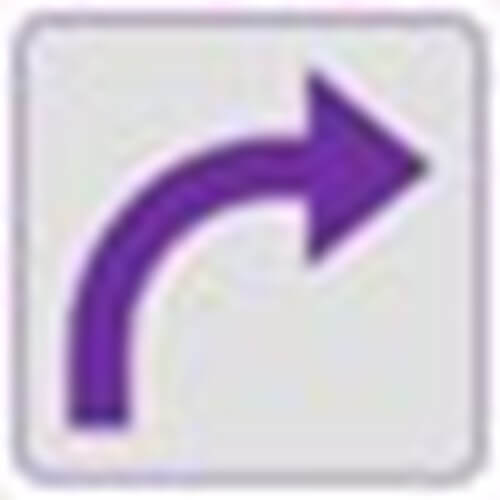
The previous direction was UP, and the current direction is RIGHT. Thus, the correct answer is RIGHT TURN.
Tip: To decide which maneuver to choose, memorize the direction of the previous arrow.
Spatial Memory
This test assesses your short-term memory, concentration abilities, and attention to detail.
You will be presented with a 4X3 grid containing 12 images. The pictures and their locations will be shown only twice, and you won't have another chance to view them. Afterward, you will be shown one image that you will need to indicate its location in the grid.
You will have 1 minute to complete as many tasks as you can.
Tip: Group pictures into smaller sets or patterns. Our brains remember chunks of information better than individual items.
Complex Control (wingChallenge)
This test assesses your hand-eye coordination.
You will be presented with a simulation where you move through h a rotating cylindrical tube.
Your task is to maneuver through the tube and steer clear of any obstacles in your path.
You will have 3 minutes to complete the task.
Tip: Make minor, precise adjustments rather than large, erratic movements. This helps you maintain control and avoid obstacles more effectively.
Multi-tasking Capability (drv)
This test measures your ability to perform several tasks at the same time.
It consists of 3 tasks that you should perform simultaneously:
Task 1 – on the left side of your screen, you will have 5 symbols, including a triangle that either points left or right. You will need to recognize in which direction the triangle is pointing and click on the respective symbol at the bottom of the screen.
Task 2 – on the right side of the screen, you will have mathematical equations. You will need to verify as quickly as possible if the equations are correct.
Task 3 – also on the right side of your screen, you will have a 7 digits sequences. You will need to check as quickly as possible if any digit appears twice and select ‘duplicate’ or ‘no duplicate.’
You will have 5 minutes to complete the test.
Tip: Since Task 1 (triangle direction) and Task 2 (mathematical equations) are on opposite sides of the screen, utilize your peripheral vision to quickly switch between tasks without losing focus.
How to Pass the AA Pilot Skills Test?
Our comprehensive AA Pilot Skills Test PrepPack provides all you need to get a high score on the American Airlines pilot assessment test, pass the test with flying colors, and land your dream job!
Accurate simulations that mimic the real test.
Detailed answers & explanations that provide clarity and understanding of the reasoning behind each question.
Study guides that teach you how to approach each type of assessment best.
Scoring reports that allow you to track your performance and show you where your strengths are and where you should focus your efforts.
FAQs
The American Airlines Pilot Skills Test, administered by AON (cut-e), is an integral part of American Airlines' pilot recruitment process.
This test assesses essential competencies required for airline pilots across 9 mini-tests.
You will be evaluated on skills such as numerical reasoning, deductive and inductive reasoning, spatial awareness, reaction speed, spatial memory, and multitasking ability.
The cognitive test for American Airlines pilots, also known as the AA Pilot Skills Test, evaluates essential competencies crucial for the role of a pilot.
Administered through AON (cut-e), it consists of 9 mini-tests focusing on different skills, such as multitasking, spatial awareness, arithmetic skills, and logical reasoning.
The American Airlines pilot aptitude test, also called the AA Pilot Skills Test, is challenging due to its rigorous assessment of various skills essential for the role, including spatial awareness, arithmetic, logical reasoning, and reaction speed.
Thus, proper preparation with realistic simulation and study guides for each type of question is crucial for getting a high score and landing the position of an American Airlines Pilot.
To pass the AA Pilot Skills Test, you need to practice as much as possible with realistic simulations, detailed study guides outlining effective approaches for each assessment type, and personalized scoring reports to track your performance and identify areas for improvement. This preparation will equip you to excel in the American Airlines pilot assessment test and increase your chances of securing your desired position as a pilot.

Looking For Other Airlines Assessments?
Airline Pilot Test Preparation | Delta Airlines Assessment Test | Delta Pilot Test | Delta Virtual Job Tryout | Delta Airlines BMAR Test | United Airlines Assessment Test | Airline Hiring Process



